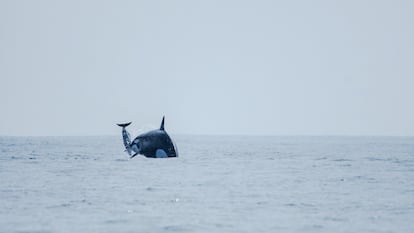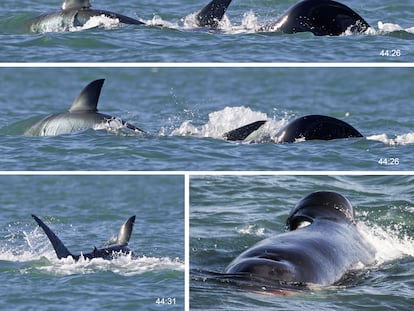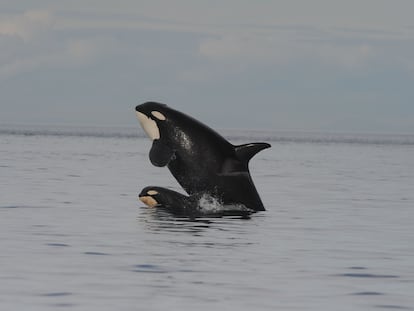Previously unknown population of killer whales corner sea lions and hunt dolphins in northern Chile
A team of scientists has managed to capture unprecedented images of a pod, led by the matriarch ‘Dakota,’ feeding on the coasts of the Antofagasta region
For the first time since records began, a pod of orcas has arrived on the coasts of northern Chile. There, marine biologists have taken advantage of this unique opportunity to study a hitherto unknown population of this elusive species, which still contains many mysteries for science. The orca is the super-apex predator of the seas, above even the great white shark in the food chain, but little is known about the hunting habits and techniques of many of its populations, which tend to live far from the coasts.
In 2018, a group of anchovy fishermen in the Chilean bay of Mejillones saw a pod of orcas up close for the first time. Hundreds of sea lions were entering and exiting their nets, attracted by the fish typical of the area. It was then that the fishermen witnessed these great ocean predators arrive — led by a female, later named Dakota by scientists — who took advantage to approach the boats and corner the sea lions to feed on them. The photos and videos of the sightings, uploaded to Facebook, later served for researcher Ana María García Cegarra and her team to begin investigating.
García Cegarra, a marine biologist at the University of Antofagasta, feels that “it is a dream come true to study these cetaceans in the wild. It is not common to see orcas so close to the shore,” she notes, as the animals can travel thousands of miles in the open sea in search of food. García Cegarra led a study, published Thursday in the journal Frontiers in Marine Science, which combines her own surveys and testimonies from the local population.
Orcas are cosmopolitan animals, present in all the world’s oceans, but there is not enough data to accurately assess their conservation status, according to the IUCN Red List of Threatened Species. In this case, the researchers tracked the hunting preferences of the pod from 2020 to 2023 between the Chilean regions of Antofagasta and Coquimbo, in waters influenced by the Humboldt Current that travels from Patagonia to Ecuador. “Understanding their role in the sea is essential to generate conservation strategies for this little-known species,” explains García Cegarra.
In the article, the expert and her colleagues explain how they also used drones to document the first images of a successful orca hunt of dusky dolphins (Lagenorhynchus obscurus). “We have seen males with calves engaging in the chase, as a kind of game,” explains García Cegarra. According to the authors, this new evidence about feeding habits can help understand how populations in the southern hemisphere are linked.
“Orcas in the southern hemisphere have been studied mainly in Antarctic waters, but further north there is a lot of misinformation,” says García Cegarra. In total, five ecotypes have been found in this part of the world, such as type A orcas (whose diet is marine mammals) and type B1, which prefer fish. Although analysis is still needed to determine which of these the Chile pod belongs to, the marine biologist believes they are type A. “We need a biopsy to analyze their genetic data,” she says, which will not be an easy task because they are very intelligent and agile animals.
Pollution and collision risks
Bruno Díaz, scientific director of the Bottlenose Dolphin Research Institute, agrees with García Cegarra on this point, as orcas are difficult to study, although he stresses that the article represents “a starting point. It is a foundation stone for future studies. It would be interesting to see how regularly they visit that area and how they catch their favorite prey in that case,” says the expert, who did not participate in the research. In addition, in their observations, the researchers noted that the orcas share their prey with their offspring, which indicates that they are reproducing, but they are unsure of the survival rate of the calves, an aspect that worries the scientist due to the high levels of ocean contamination, especially in Mejillones.
“We believe that maritime traffic and the risk of collision are threats to the orcas, as is pollution. The bay is a port terminal for the transport of goods and mining supplies and we are concerned about the survival of the calves, because the mothers can accumulate metals and other contaminants that adhere to the fat and breast milk,” warns García Cegarra. Mejillones is one of the five sacrifice zones (a term used for areas of intense industrial activity) in Chile. For decades, the environment has been steadily affected by industrial activity and the presence of at least eight coal-fired power plants that should close before 2030, according to the decarbonization plan promoted by the Chilean government.
Along these lines, Ricardo Aguilar, director of expeditions for the NGO Oceana, mentions that in general, in coastal areas where orcas live, there is already “a fairly high level of interaction with humans. For example, in the case of Spain, with the population of orcas in the Strait of Gibraltar; they tend to interact with ships that pass through the area. What should be done is to adopt measures so that they can be preserved and that there are no such impacts by humans,” says Aguilar, who was not part of the study.
Sign up for our weekly newsletter to get more English-language news coverage from EL PAÍS USA Edition
Tu suscripción se está usando en otro dispositivo
¿Quieres añadir otro usuario a tu suscripción?
Si continúas leyendo en este dispositivo, no se podrá leer en el otro.
FlechaTu suscripción se está usando en otro dispositivo y solo puedes acceder a EL PAÍS desde un dispositivo a la vez.
Si quieres compartir tu cuenta, cambia tu suscripción a la modalidad Premium, así podrás añadir otro usuario. Cada uno accederá con su propia cuenta de email, lo que os permitirá personalizar vuestra experiencia en EL PAÍS.
¿Tienes una suscripción de empresa? Accede aquí para contratar más cuentas.
En el caso de no saber quién está usando tu cuenta, te recomendamos cambiar tu contraseña aquí.
Si decides continuar compartiendo tu cuenta, este mensaje se mostrará en tu dispositivo y en el de la otra persona que está usando tu cuenta de forma indefinida, afectando a tu experiencia de lectura. Puedes consultar aquí los términos y condiciones de la suscripción digital.
More information
Archived In
Últimas noticias
Most viewed
- Sinaloa Cartel war is taking its toll on Los Chapitos
- Oona Chaplin: ‘I told James Cameron that I was living in a treehouse and starting a permaculture project with a friend’
- Reinhard Genzel, Nobel laureate in physics: ‘One-minute videos will never give you the truth’
- Why the price of coffee has skyrocketed: from Brazilian plantations to specialty coffee houses
- Silver prices are going crazy: This is what’s fueling the rally












































